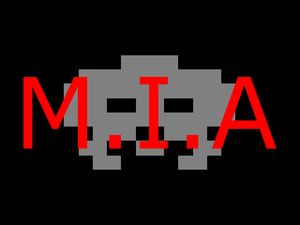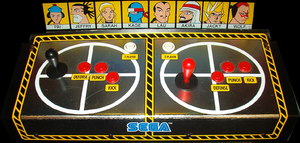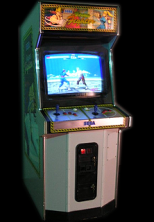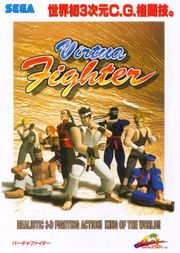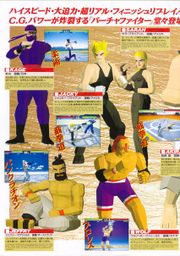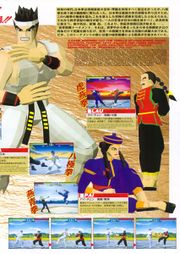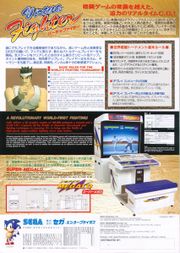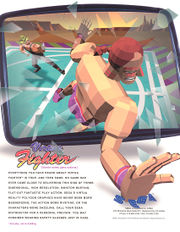Lost In Translation/Virtua Fighter
| Virtua Fighter | |
|---|---|
| Manufacturer | Sega |
| Released | 1993 |
| Control Method |
8-way Joystick 3 Button(s) |
| Main CPU | V60 (@ 16.000 MHz) 68000 (@ 10.000 MHz) |
| Sound CPU | Stereo YM3438 (@ 8.000 MHz) (2x) MultiPCM (@ 8.000 MHz) |
| Video Details |
Raster (Horizontal) 496 x 384 pixels 60.00 Hz 8,192 Palette colours |
| Screens | 1 |
| ROM Info | 26 ROMs 30,932,992 bytes (29.50 MiB) |
| MAME ID | vf |
About The Game
Virtua Fighter is a 3-D, one-on-one fighting arcade video game.
The battle system is simple, yet complex. There are 3 buttons : Punch, Kick and Guard. Movement is strictly confined to a horizontal plane.
Battles are won by draining the energy bar of your opponent or by pushing your opponent off the edges of the ring (known as a 'Ring-out').
When a 'Draw' is declared (timer reaches zero with both fighters having an equal amount of energy), a Sudden Death match is held on a very small platform, making a win by Ring-out that much more probable.
The game favours tactical play over mindless button bashing, and the gameplay is balanced accordingly to reflect this.
Trivia
An instant success in Japanese arcades, Virtua Fighter (or VF for short) brought the versus beat 'em up kicking and screaming into the next generation. Like "Street Fighter II - The World Warrior", a substantial number of clones ("Toshinden", "Tekken", "Dead or Alive") would follow in its wake, each with their own tweaks to the formula.
Among the game's many innovations, the most profound were the true-to-life animation (all the more impressive considering no motion capture technology was used) and the realistic move-sets of the game's eight characters.
Virtua Fighter serves 180,000 polygons per second. This is the first 3-D polygonal one-on-one fighting game.
During Virtua Fighter's development, the game featured an Arabian fighter named 'Siba'. He was replaced later on in the final prototypes by Akira, as the developers felt that the game needed a karate fighter similar to Street Fighter's Ryu. Siba was brought back as an unlock-able character in the Saturn game 'Fighter's Megamix', in all his VF1 style glory.
Tips and tricks
Play as Dural
First, you must beat the computer Dural and have 2 games worth of credits in the machine ready to go. After beating the game, have one player press Start and pick a character. As soon as that character finishes smiling, but before the game actually starts, player 2 should press Start to interrupt the process. If your timing is perfect, and the stars are perfectly aligned, and you've been a good boy or girl, player 2 may come in as Dural.
See Credits
You can get the credits of the programmers to come up on the screen by holding down a Start button during the demo. When it comes to the standard demo with Sarah kicking Kage, the credits will come up. Keep holding the Start button to keep the credits coming or else they will freeze.
Kage's Face Mask
It seems that after about 3,000 plays, the mask on Kage falls off instead of just his headband. You can see his teeth and a scar on his cheek.
Series
- Virtua Fighter (1993)
- Virtua Fighter 2 (1995)
- Virtua Fighter Remix (1995)
- Virtua Fighter Kids (1996)
- Virtua Fighter 3 (1997)
- Virtua Fighter 4 (2001)
- Virtua Fighter 4 Evolution (2002)
- Virtua Fighter 10th Anniversary (2003, Sony PlayStation 2)
- Virtua Fighter 4 Final Tuned (2004)
- Virtua Fighter Cyber Generation - Judgment Six No Yabou (2004, Sony PlayStation 2)
- Virtua Fighter 5 (2006)
- Virtua Fighter 5 R (2008)
Staff
- Coordinator & Main Designer
- Seiichi Ishii
- Main Programmer
- Toru Ikebuchi
- Programmers
- Shin Kimura
- Takeshi Suzuki
- Eisuke Miura
- Kazuhiko Yamada
- Masahiko Kobayashi
- Naomi Ota
- F.Y. Bertrand
- Tetsuya Kaku
- Designers
- Kunihiko Nakata
- Youji Kato
- Toshiya Inoue
- Yoshinao Asako
- Masataka Aochi
- Tomohiro Ishii
- Jeffery Buchanan
- Mika Kojima
- Program Supports
- Keiji Okayasu
- Hiroaki Shoji
- Music Composer
- Takayuki Nakamura
- Planning Support
- Manabu Tsukamoto
- Producer & Director
- Yu Suzuki
Cabinet and Artwork
Ports
- Consoles
- Sega Saturn (1994)
- Sega 32x (1995)
- Sega Master System (1996, "Virtua Fighter Animation")
- Sega Game Gear (1996, "Virtua Fighter Mini")
- Computers
- PC [MS Windows 9x, CD-ROM] (1996)
Soundtrack Releases
| Album Name | Catalogue No. | Released | Publisher | Comments |
|---|---|---|---|---|
| Virtua Fighter "Sega Saturn" Image by B-univ: Neo Rising | TYCY-5406[1] | 1994-12-21 | Toshiba EMI | CD version. |
| Virtua Fighter & Virtua Fighter 2 MUSIC TRACKS | TYCY-5480~1[2] | 1996-01-31 | Toshiba EMI | 2 CD version. |
| Virtua Fighter | TYCY-5386[3] | 1994-03-23 | Toshiba-EMI | CD version. |
| SEGA Saturn Virtua Fighter Maximum Mania | TYCY-5409[4] | 1994-11-30 | Toshiba EMI | CD version. |
| SEGA Saturn History ~Saturn Was Young~ First Volume | WWCE-31052~3[5] | 2004-10-27 | Wave Master | 2 CD version. |
| Club Saturn | MM 86013-2[6] | 1997-11-11 | Breakdown Records | CD version. |
| CLUB SEGA | MJCA-00003[7] | 1997-10-17 | Marvelous Entertainment | CD version. |
| Saturn Sampler Audio CD | MMSJAN96[8] | 1996-01-01 | Mean Machines Sega | CD version. |
| Virtua Fighter ~ Akira/Kage | TYDY-2056[9] | 1994-01-19 | Futureland / Toshiba EMI | CD version. |
References
- ↑ Virtua Fighter "Sega Saturn" Image by B-univ: Neo Rising (CD) at the VGMdb
- ↑ Virtua Fighter & Virtua Fighter 2 MUSIC TRACKS (CD) at the VGMdb
- ↑ Virtua Fighter (CD) at the VGMdb
- ↑ SEGA Saturn Virtua Fighter Maximum Mania (CD) at the VGMdb
- ↑ SEGA Saturn History ~Saturn Was Young~ First Volume (CD) at the VGMdb
- ↑ Club Saturn (CD) at the VGMdb
- ↑ CLUB SEGA (CD) at the VGMdb
- ↑ Saturn Sampler Audio CD (CD) at the VGMdb
- ↑ Virtua Fighter ~ Akira/Kage (CD) at the VGMdb



